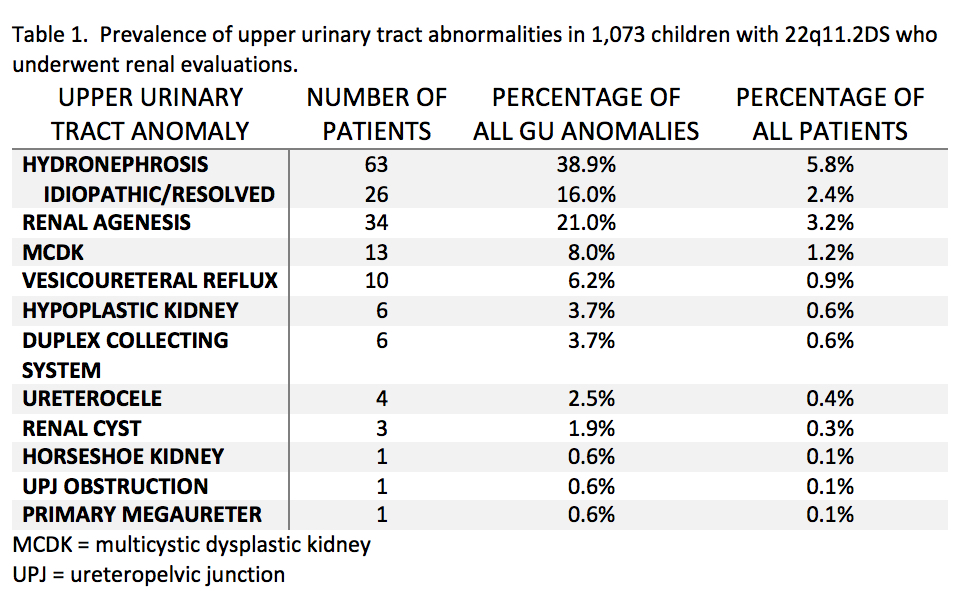Anomalies Of The Genitourinary Tract In Children With 22q11.2 Deletion Syndrome
Jason P. Van Batavia, MD1, T. Blaine Crowley, BA1, Evanette Burrows, BS1, Elaine H. Zackai, MD1, Simone Sanna-Cherchi, MD2, Donna M. McDonald-McGinn, MS, CGC1, Thomas F. Kolon, MD1.
1The Children's Hospital of Philadelphia, Philadelphia, PA, USA, 2Columbia University Medical Center, New York, NY, USA.
BACKGROUND: The 22q11.2 deletion syndrome (22q11.2DS), of which the DiGeorge syndrome is most common, involves multiple organ systems with variable phenotypic expression. The most common features include conotruncal cardiac anomalies, immunodeficiency, gastrointestinal, palatal and skeletal abnormalities, and developmental delay. In addition, genitourinary tract abnormalities, especially renal anomalies, have been noted to be present in up to 30-40% of patients, although most of these studies are small, retrospective reviews with significant selection bias (ie, including only patients referred to urologist or those who underwent renal/bladder ultrasound [RBUS] for specific indication and not for routine screening). At our institution, an internationally recognized, comprehensive and multidisciplinary 22q11.2DS care center has been providing care to these children with routine screening RBUS. We hypothesized that in this large prospectively managed cohort of all 22q11.2DS patients evaluated at a single institution, the prevalence of genitourinary anomalies would be higher than expected in the general population but less than seen in prior, smaller, studies.
METHODS: We retrospectively reviewed the charts of all patients who underwent a complete evaluation at our institution's 22q11.2DS center from 1992 to March, 2017. Using our electronic medical record (EMR) system, Epic (Epic Systems Corp., Madison, Wisconsin) and diagnosis specific codes, we identified all children with any genital or urinary tract anomaly. For all children with a diagnosis of hydronephrosis (either diagnosed antenatal or postnatal), the underlying etiology for the hydronephrosis was determined based on additional diagnosis codes for that child.
RESULTS: Overall, of the 1,267 patients seen in our institution's 22q clinic, 649 are boys and 618 are girls. Of the 1,073 children with 22q11.2DS who underwent renal evaluations, 162 (15.1%) have structural abnormalities of their kidneys/urinary tracts (Table 1). While hydronephrosis was the most common upper tract finding, the majority (63%) had isolated upper tract dilation without any additional diagnoses. In terms of genital anomalies, boys were significantly more likely to be diagnosed with an abnormality than girls (7.7% vs. 0.5%, p < 0.001, Fisher exact test). Of the 649 boys, 24 (3.7%) had cryptorchidism and 24 (3.7%) had hypospadias, which was noted to be mild (megameatus or glanular) in all except 1 boy. The only female genital anomalies noted were vaginal agenesis in 2 patients and uterine agenesis in 1 patient.
CONCLUSIONS: In this large single institution review of patients with 22q11.2DS, 15.1% have associated renal or structural urinary tract anomalies. Findings of hydronephrosis, unilateral renal agenesis, and multicystic dysplastic kidney occur at higher rates than expected in the general population, although in the majority no surgical intervention is necessary. Genital abnormalities occur more often in boys than girls. Despite the higher than expected rate of hypospadias, most are mild distal hypospadias. Given these findings, in addition to routine physical examination, we believe that all patients with 22q11.2DS warrant screening RBUS at time of diagnosis.
Back to 2017 Program
